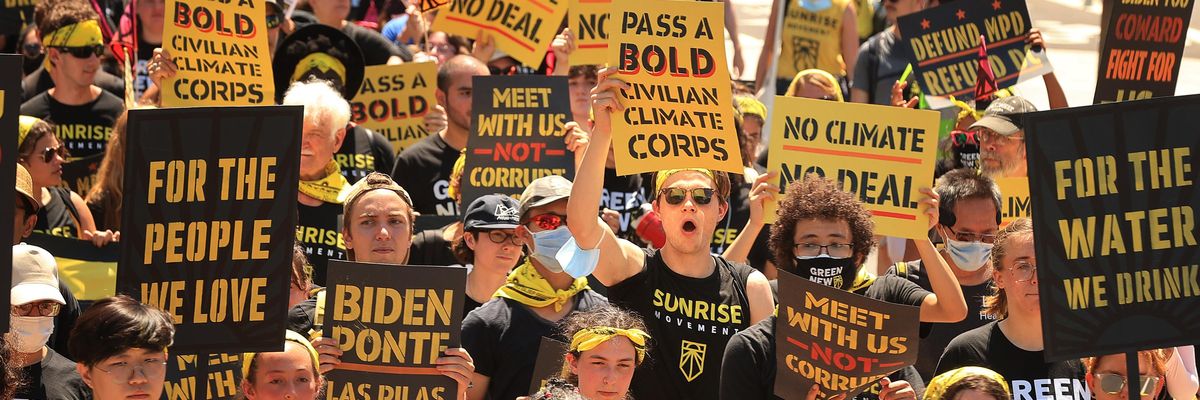The year is 1942. The Japanese have bombed Pearl Harbor. The Nazis have invaded Russia and declared war on America. President Franklin D. Roosevelt addresses the nation to make an important announcement: The White House is launching a drive to recruit 20,000 Americans to fight for our collective survival.
The idea, of course, would have been laughable — a response utterly inadequate to the threat then posed by global fascism. In reality, during his 1942 State of the Union address, FDR announced a list of massively ambitious wartime goals, from industrial production, to collective public determination, to the global deployment of American troops. “We must raise our sights,” he told the nation. “Let no man say it cannot be done.” He did not launch a website to recruit a mere 20,000 soldiers.
Yet this is precisely the type of half-measure actions the Biden administration is taking in tackling the climate crisis.
The latest such move came last week as the White House announced the formation of an American Climate Corps to recruit 20,000 Americans to install solar and wind systems, rebuild wetlands, restore forests, and more. Are these jobs vital to save as much of the world as we can? Absolutely. But just as victory against the Axis Powers rested on the backs of millions of Americans, and an emergency wartime mobilization from coast to coast, victory against the climate crisis will require exponentially more than 20,000 recruits. Pretending otherwise is not only a failure of imagination, it is a tacit surrender to the greatest threat we have yet faced as a people.
President Biden’s American Climate Corps contains echoes of FDR’s Civilian Conservation Corps, which — as part of the New Deal — put over 3 million American men to work on public lands during the Great Depression. Unlike Biden’s plan, however, FDR seemed to mean business from the start: Within days of the executive order that established the corps, the agency had already recruited its first enrollees; two weeks later, it had opened its first camp, in George Washington National Forest. And just three months after its creation — in an astonishing feat of mobilization — the Civilian Conservation Corps employed over 300,000 Americans at 1,400 camps across the country.
By comparison, Biden’s American Climate Corps — also issued by executive order — offers vague timelines and few concrete plans for deployment. In rare cases where details do exist, they are underwhelming; the newly established “Forest Corps,” to take one example, will be tasked with “wildland fire prevention, reforestation, and other natural and cultural resource management projects.” Make no mistake, this is a good proposal that is desperately needed, as evidenced so tragically this summer by the deadly firesin Maui. Yet Biden’s plan calls for hiring just 80 people and “beginning next summer.”
A similar failure in ambition is occurring with industrial manufacturing. One month after the bombing of Pearl Harbor, at his State of the Union address, FDR announced the goal of producing 60,000 planes. Skeptics scoffed at such a lofty plan, yet by 1944 the United States had manufactured over 220,000 planes. Similar feats of industrial ambition occurred across the American economy, from the production of tanks to ships to rubber and more, not because FDR offered low-interest loans and tax incentives to American companies but because he took seriously the existential emergency that we faced as a people. He invoked the War Powers Act, he demanded the “impossible,” and the nation rose to the challenge, not only meeting his expectations but exceeding them.
FDR’s wartime mobilization stands in stark contrast to the incremental, market-based climate solutions favored by the Biden administration. The American economy remains the largest in the world, and the United States should have, years ago, become a global factory for solar panels, wind turbines, electric vehicles, batteries, and more. But between the climate allocations in the Inflation Reduction Act ($370 billion) and the Bipartisan Infrastructure Bill ($250 billion), it has committed less than 2 percent of total funding that experts believe is needed for a meaningful green transition of the US economy within a time frame set for 2029. Furthermore, climate provisions in both bills promote adaptation over mitigation or — worse — simultaneous streamlining fossil fuel development and extraction alongside green energy projects.
So what should Biden do? He must lead like FDR. He must set climate goals that sound less like an effort to fulfill a campaign promise and more like a strategy to successfully address the greatest existential threat we have faced as a planet. And he needs to act now. This past summer, the hottest on human record, was not “the new normal,” as some claim; it was a momentary stop on the route to a far more lethal climate.
The 1930s and ’40s demonstrated what we can achieve as a nation under ambitious leadership. We faced a seemingly invincible, all-powerful enemy and we rallied as a people to win. If we could achieve such monumental feats of logistical planning and rapid, nationwide scaling in a time before satellites and the internet, surely we can do better now. We have to.
